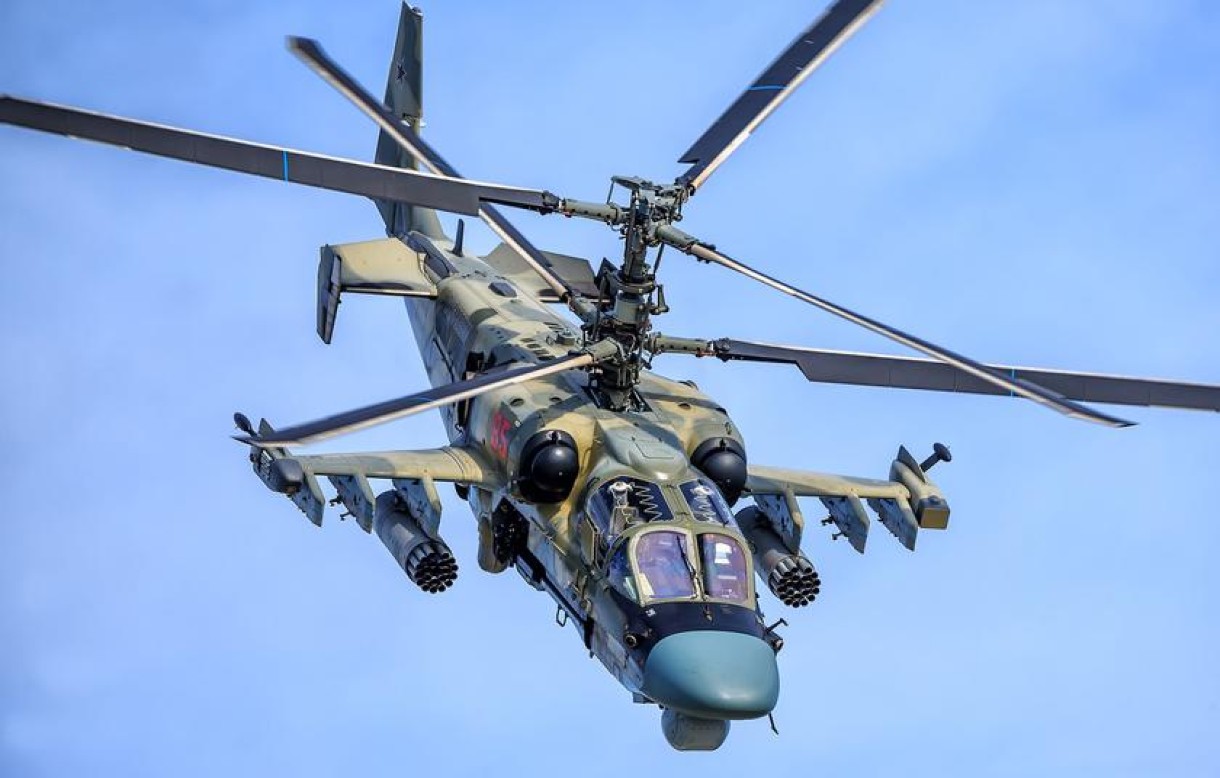Russia is employing Ka-52 Alligator assault helicopters and Mi-8 MTPR-1 electronic warfare (EW) choppers to attack Ukrainian ground targets, according to videos released by its Ministry of Defense (MoD).
Ka-52 is an unorthodox contra-rotor/co-axial rotor heavy helicopter gunship used most widely in the war and consequently saw the most casualties. The Mi-8 MTPR-1 helicopter is an upgraded version of the standard Mi-8MTV-5-1 outfitted with the Richag-AV EW system.
The publicity video showed the two helicopters taking off together and the Ka-52 attacking Ukrainian ground positions, indicating that the Mi-8 MTPR-1 jams air defense radars to protect the Ka-52.
Publicized in combat for the first time in October last year, the Russian army seems to have perfected the use of the unconventional platform after extensive losses of the Ka-52. It first appeared at an undisclosed location in unofficial photographs in April last year.
Whether the MTPR-1’s development was specifically meant for supporting the Ka-52 anticipating the war in Ukraine, or a general effort towards possessing a diverse range of EW platforms, is unclear. But despite losing around 27 such helicopters to most Man-Portable Air Defense (MANPAD) while flying at low altitudes, the continued usage of the helicopter means the VVS retains confidence in the platform.
The introduction of the MTPR-1 and the rapidly depleting Ukrainian S-300 and Buk surface-to-air (SAM) will, at some point, leave Ukraine with only the limited Western air defense systems, which themselves are draining North Atlantic Treaty Organization (NATO) financially and equipment-wise.
Russian MoD Video
The video shows a ground crewman inserting rockets into the pod on the starboard (right) side of the weapons carrier and the shot then cutting to the Alligator and the MTPR-1 on the tarmac, with their main rotors running before takeoff. The markings of the formation, unit and aircraft serial numbers are blurred to not disclose the location and the base they are operating from.
Both helicopters take off, with the MTPR-1 trailing slightly behind.

The rest shows selfie videos from cameras attached around the Ka-52 and inside the cockpit (with blurred displays).
It fires flares to divert heat-seeking missiles, pitches up, and fires the rockets from the top of the arc before yawing a hard right. This tactic had previously been noted by the EurAsian Times to increase the range of the possibly unguided rockets.
The statement accompanying the video said the “pilots of the Army Aviation launched missiles at the detected strongpoints and hardware of the Armed Forces of Ukraine (AFU).”
Subsequent shots from selfie cameras from the missile’s nose and the tail boom show the volley of rockets fired from pods on both wings simultaneously. The helicopter is then shown landing back.
I Jam, You Shoot!
The Mi-8 MTPR-1 is outfitted with the Richag-AV EW system, developed and manufactured by the Kazan Optical and Mechanical Plant (KOMZ), a division of the Radio-Electronic Technologies Concern. It can be integrated into Russian rotary-wing aircraft, ships, and other military platforms like aircraft and ground vehicles.
In this case, it has been retrofitted on the Mi-8, with possibly minimal changes to the aircraft’s airframe.
The Richag-AV can interfere with sophisticated sensors from 100 kilometers away by using multi-beam antenna arrays and a Digital Radio Frequency Memory (DRFM) device to counter radiofrequency-based weapon systems.
The system possesses an inbuilt database against it, which scans a detected frequency from a radar, identifies it, and then employs an appropriate jamming technique and strategy. The cargo/passenger compartment is separated into two sections on the Mi-8MTPR-1.
The wider rear portion houses the Rychag-AV system’s hardware, while the smaller front portion houses the system operator’s station.
It operates in fully autonomous, semi-automatic, and manual modes, where the electromagnetic spectrum scanning and the subsequent jamming can be conducted automatically or with human intervention. The KOMZ has so far modified around 20 Mi-8s into MTPR-1 versions and delivered them to the Russian military by 2017.
In the video, the helicopter seemed to fly in low altitudes, keeping it within the range of MANPAD missiles like the US-made Stinger and Soviet-origin Igla systems. It wouldn’t be too far-fetched to assume it can jam anti-aircraft missiles with a radio-frequency seeker that locks to radio and radar waves emitted from a target aircraft.

Tough Nut To Crack!
In a previous EurAsian Times article about a video showing a MANPAD missile missing an incoming Geran-2 kamikaze drone from a close distance in a simple straight line shot, experts had attributed it to the absence of any electromagnetic or heat exhaust (infra-red) emission.
Moreover, Ukraine has been assessed to have deployed many critical air defense systems like the S-300, Buk, and German-origin IRIS-T on the frontlines, which puts the Ka-52 in harm’s way.
However, Ka-52s still are being shot down, with the latest reported shooting down of a single Alligator claimed by Ukraine on January 9, along with a Mi-24, a Mi-8, and an Orlan-10 drone. It is unclear whether it was the victim of larger SAM systems or a MANPAD.
The Ka-52 is designed to take punishment and withstand 12.7mm armor-piercing rounds and 23mm projective fragments, while both contra-rotating rotors can withstand small arms fire.
A near intact Ka-51 Alligator close to the Gostomel airfield from the early days of the war indicated that the pilots must have decided to land only after an anti-aircraft fire hit critical systems and comfortably exited it to be possibly rescued by their friendly forces.
- The author can be reached at satamp@gmail.com
- Follow EurAsian Times on Google News




